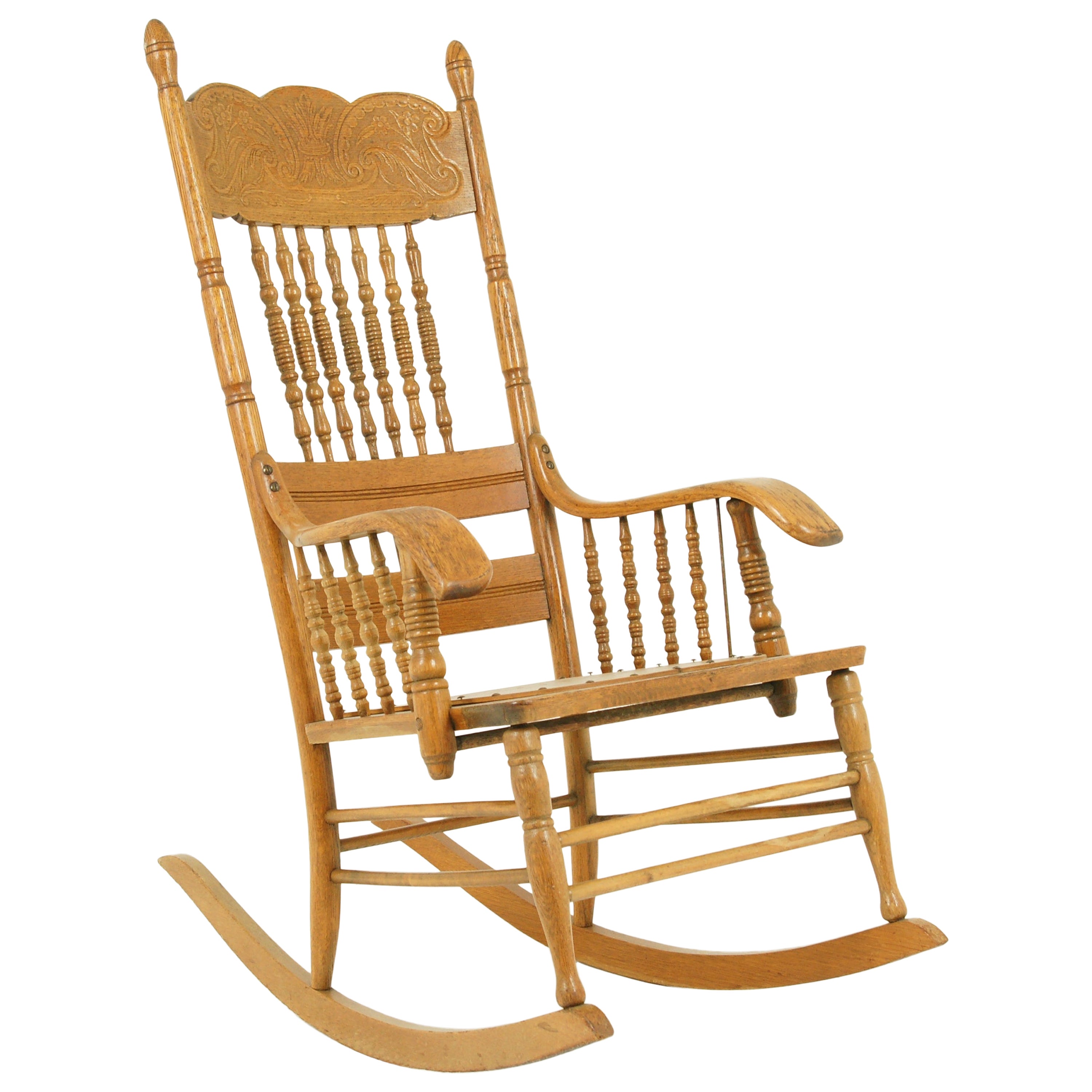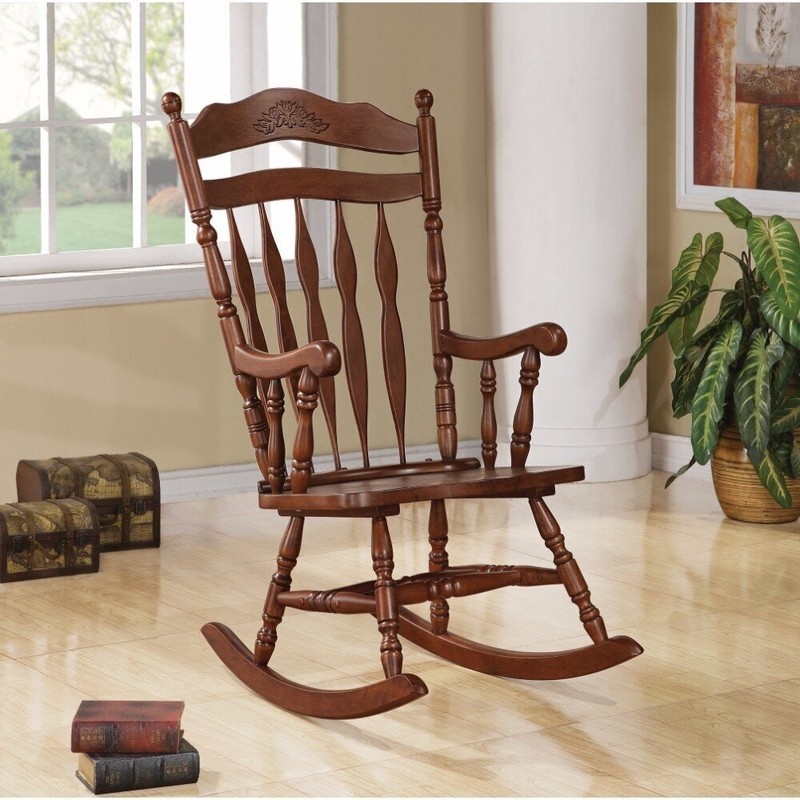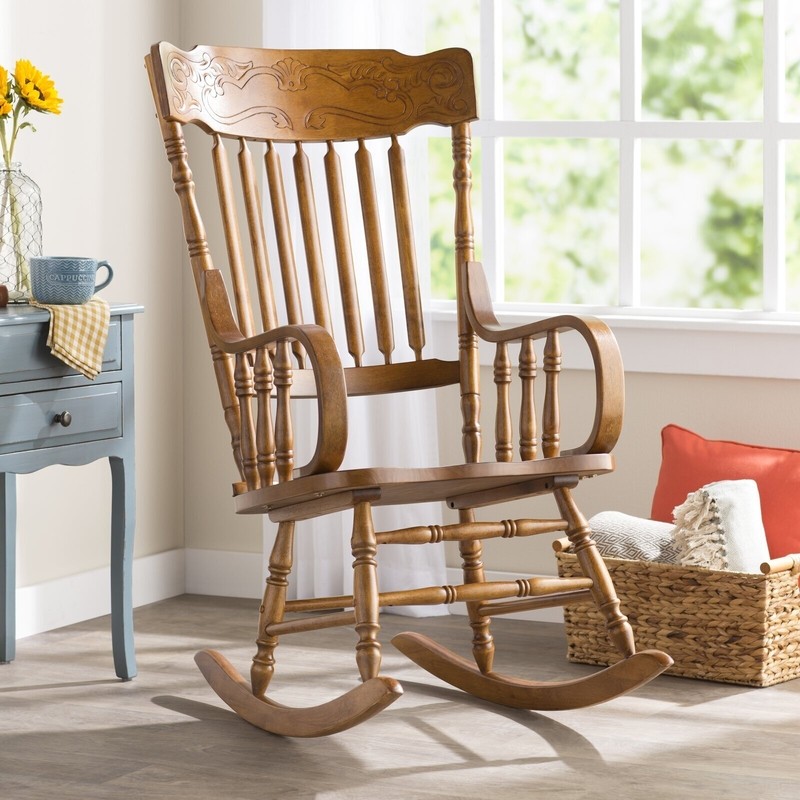History and Craftsmanship

The rocking chair, a quintessential symbol of comfort and relaxation, has a rich history intertwined with the evolution of furniture design and the use of wood. The journey of this iconic piece spans centuries, with oak, a durable and aesthetically pleasing hardwood, playing a pivotal role in its development.
The Evolution of the Rocking Chair
The rocking chair’s origins can be traced back to the 18th century, with early examples appearing in Europe and America. The concept of rocking motion, however, existed long before, with rudimentary rocking devices used in ancient civilizations. Early rocking chairs were often constructed from simple materials like wood and leather, and their design was largely utilitarian. The use of oak, known for its strength and durability, quickly became a favored choice for rocking chair construction, particularly in America.
Traditional Woodworking Techniques, Antique solid oak rocking chair
The craftsmanship of antique solid oak rocking chairs is a testament to the skill and artistry of generations of woodworkers. Traditional techniques, passed down through apprenticeships, were employed to create these enduring pieces. These techniques included:
- Mortise and Tenon Joints: This time-honored method involves creating interlocking pieces, with a tenon (projection) fitting snugly into a mortise (hole) to create a strong and durable joint. Oak’s density and grain pattern made it an ideal wood for this technique.
- Dovetail Joints: A dovetail joint is a strong, interlocking joint, with a series of wedge-shaped pins (tails) fitting into corresponding slots (pins) in the other piece. This technique was often used for joining the chair’s legs to the seat.
- Hand-Planing: Woodworkers used hand planes to shape and smooth the oak planks, creating a refined and elegant finish. The unique grain patterns of oak, often highlighted through hand-planing, contributed to the chair’s beauty.
Renowned Makers and Their Contributions
Several renowned makers left an indelible mark on the design and craftsmanship of antique solid oak rocking chairs:
- Samuel Gragg (1762-1845): A prominent New England chairmaker, Gragg is known for his distinctive style of rocking chairs, featuring a high back and curved arms. He used oak extensively, recognizing its durability and aesthetic qualities.
- John Henry Belter (1807-1863): Belter, a German-born American cabinetmaker, revolutionized furniture design with his innovative techniques for bending and laminating wood. His rocking chairs, often crafted from oak, showcased intricate carvings and graceful curves.
- The Windsor Chair: While not solely made from oak, the Windsor chair, a popular style in the 18th and 19th centuries, often incorporated oak for its strength and durability. The chair’s distinctive features include a turned spindle back and a saddle seat.
Oak vs. Other Woods
Antique rocking chairs were crafted from various woods, each with unique properties that influenced their design and durability. Oak’s durability, strength, and beautiful grain patterns made it a preferred choice for rocking chairs. However, other woods, such as cherry, maple, and walnut, were also used.
- Cherry: Known for its rich reddish-brown color and fine grain, cherry wood was often used for chairs that emphasized elegance and beauty. However, cherry is softer than oak, making it less durable for rocking chairs.
- Maple: Maple wood is known for its strength, hardness, and beautiful grain patterns. It was often used for rocking chairs that required durability and a visually appealing finish. Maple is slightly harder than oak, but not as durable.
- Walnut: Walnut wood is prized for its rich color, distinctive grain patterns, and durability. It was often used for rocking chairs that showcased elegance and sophistication. Walnut is slightly softer than oak, but more resistant to scratches.
Design and Aesthetics: Antique Solid Oak Rocking Chair

Antique solid oak rocking chairs are not just functional pieces of furniture; they are also works of art that reflect the aesthetic sensibilities of their time. Their distinctive features, ranging from form and proportions to ornamentation, speak volumes about the craftsmanship and design principles that prevailed during their creation.
Styles and Variations
The design of antique solid oak rocking chairs evolved over time, mirroring the changing tastes and trends in furniture design.
- Queen Anne (Early 18th Century): Characterized by a graceful, curvilinear form, often featuring cabriole legs and a distinctive “S” curve in the back. These chairs often incorporated intricate carvings and decorative elements, such as shell motifs and acanthus leaves.
- Victorian (Mid-19th Century): Victorian rocking chairs are known for their elaborate ornamentation, often featuring heavy, ornate carvings, turned spindles, and intricate upholstery. They were often made in a variety of styles, including Gothic Revival, Eastlake, and Aesthetic.
- Arts & Crafts (Late 19th and Early 20th Centuries): Arts & Crafts rocking chairs embraced a simpler, more functional aesthetic, emphasizing natural materials and handcrafted details. They often featured sturdy construction, straight lines, and minimal ornamentation.
Unique Design Elements and Craftsmanship
Antique solid oak rocking chairs showcase a wide range of unique design elements and craftsmanship.
- Turned Spindles: Many antique rocking chairs feature turned spindles, which were often crafted using a lathe to create intricate and decorative patterns. These spindles could be found in the back, arms, and legs of the chair.
- Intricate Carvings: Carvings were often used to enhance the aesthetic appeal of antique rocking chairs. These carvings could be found on the chair’s back, arms, legs, and even on the rocker runners. Carvings ranged from simple geometric patterns to elaborate floral motifs and scenes.
- Hand-Painted Decoration: Some antique rocking chairs were adorned with hand-painted decoration, often featuring floral designs, landscapes, or scenes from mythology. These paintings were typically done with oil paints and could be found on the chair’s back, seat, or even on the rocker runners.
Table Comparing Different Styles
| Style | Key Characteristics |
|---|---|
| Queen Anne | Graceful, curvilinear form, cabriole legs, “S” curve in the back, intricate carvings, shell motifs, acanthus leaves. |
| Victorian | Elaborate ornamentation, heavy carvings, turned spindles, intricate upholstery, Gothic Revival, Eastlake, Aesthetic styles. |
| Arts & Crafts | Simple, functional aesthetic, natural materials, handcrafted details, sturdy construction, straight lines, minimal ornamentation. |
Value and Appreciation

The value of an antique solid oak rocking chair is influenced by a variety of factors, including its age, condition, maker, and rarity. Understanding these factors is essential for collectors and enthusiasts interested in acquiring and appreciating these pieces of furniture history.
Factors Influencing Value
The value of an antique solid oak rocking chair is determined by a combination of factors.
- Age: Older rocking chairs generally command higher prices than newer ones. Antique rocking chairs from the 18th and 19th centuries are particularly sought after.
- Condition: The condition of a rocking chair is a major factor in its value. Well-preserved chairs with original finishes and minimal wear and tear are more valuable than those that have been damaged or restored.
- Maker: Rocking chairs made by renowned furniture makers, such as the Shaker community or prominent cabinetmakers, are highly prized. The maker’s signature or label can significantly increase the value.
- Rarity: Rare rocking chairs, such as those with unique designs or materials, are highly collectible and can fetch impressive prices.
Authenticating and Dating Antique Rocking Chairs
Authenticating and dating antique rocking chairs requires expertise and a thorough examination.
- Style and Design: Experts can identify the age of a rocking chair based on its style and design. Rocking chairs from different periods have distinct characteristics.
- Construction Techniques: The construction techniques used in a rocking chair can provide clues about its age. For example, early rocking chairs often used hand-cut dovetail joints, while later chairs might have used machine-cut joints.
- Materials: The type of wood used in a rocking chair can also be an indicator of its age. Early rocking chairs were often made from hardwoods like oak, maple, or cherry.
- Hardware: The hardware used on a rocking chair, such as hinges, screws, and nails, can also be used for dating. Older rocking chairs often have hand-forged hardware, while later chairs might have machine-made hardware.
- Documentation: Any documentation associated with a rocking chair, such as bills of sale, photographs, or family histories, can be invaluable for authentication and dating.
Notable Antique Rocking Chairs
Several antique rocking chairs have achieved high prices at auctions and sales.
- Shaker Rocking Chair: A rare Shaker rocking chair, believed to have been made in the early 19th century, sold for over $1 million at a Sotheby’s auction in 2014.
- Chippendale Rocking Chair: A Chippendale-style rocking chair, dating back to the 18th century, sold for over $500,000 at a Christie’s auction in 2016.
Resources and Tips for Collectors
For collectors interested in acquiring and preserving antique solid oak rocking chairs, several resources and tips can be helpful.
- Antique Dealers and Auction Houses: Antique dealers and auction houses are excellent sources for finding antique rocking chairs. Be sure to do your research and choose reputable dealers.
- Antique Shows and Fairs: Antique shows and fairs offer a great opportunity to browse a wide selection of antique rocking chairs and meet with dealers and collectors.
- Online Resources: Several online resources, such as auction websites, antique forums, and blogs, can provide information about antique rocking chairs.
- Expert Appraisals: Before purchasing an antique rocking chair, it is wise to have it appraised by an expert. This will help you determine its authenticity, condition, and value.
- Preservation and Restoration: Antique rocking chairs should be handled with care and preserved properly. If restoration is necessary, it is important to find a qualified conservator who specializes in antique furniture.
Antique solid oak rocking chairs, with their timeless elegance and sturdy construction, are often cherished family heirlooms. Capturing the essence of these chairs on paper can be a rewarding artistic endeavor. For those interested in learning how to draw a rocking chair, a comprehensive step-by-step guide can be found here.
Once mastered, this skill can be applied to drawing antique solid oak rocking chairs, highlighting their unique details and graceful curves.
While an antique solid oak rocking chair evokes a sense of timeless comfort and tradition, the modern world offers a different kind of relaxation. The Sogno Dreamwave massage chair provides a technologically advanced approach to stress relief, utilizing targeted massage techniques and customizable settings.
In contrast to the gentle sway of a rocking chair, the Dreamwave offers a dynamic and invigorating experience, showcasing the evolution of comfort in the 21st century.